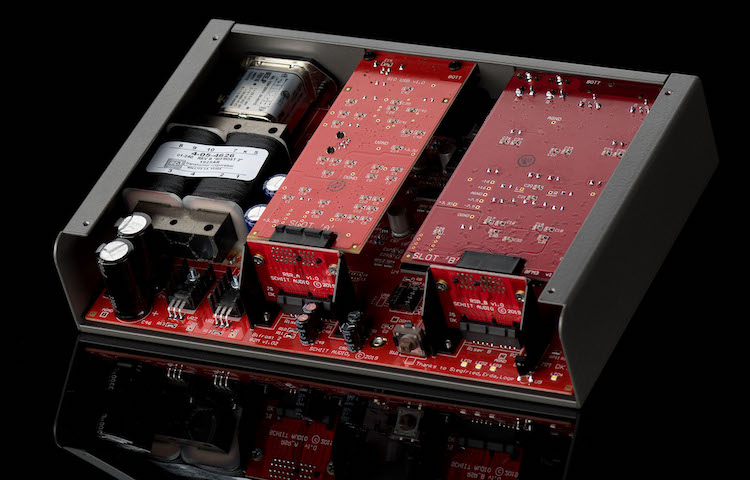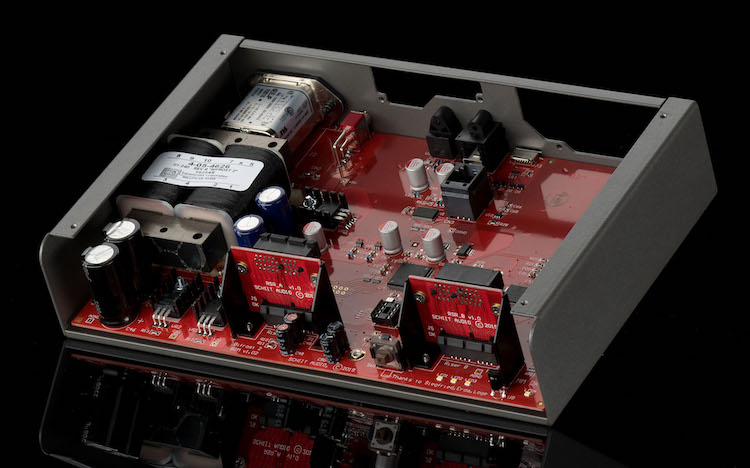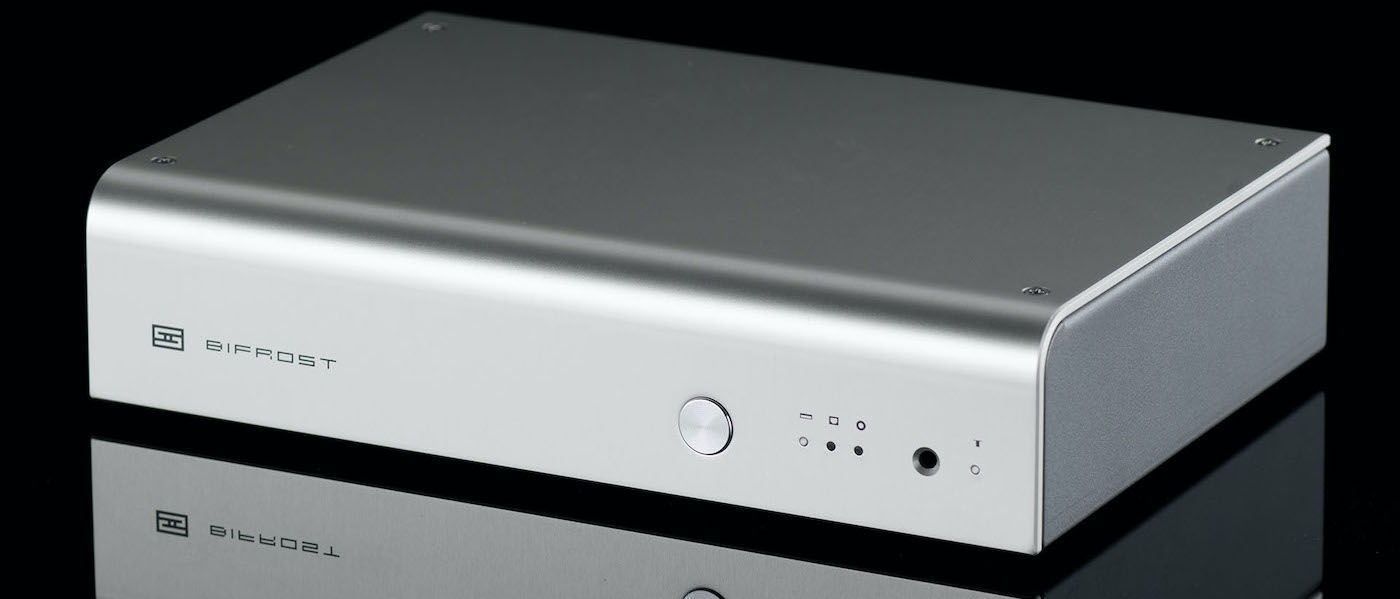
With there being so much innovation with digital audio lately, it’s natural to want the best sound quality you can get out of the playback components you already own. Most of us already have several ways to play digital music, such as CD and DVD players, or mobile devices and computers. The hardware required to make your digital audio sound as analog as possible has been around for quite some time. And that’s the Digital to Analog Converter or DAC. DACs come in many shapes, sizes, and price ranges, and that’s not even covering the math, engineering, and design that go into a DAC. But the challenge with DACs nowadays is that they are constantly changing, so that a DAC you buy today will likely be improved upon in the near future and you’ll want to upgrade. And that upgrade usually requires you to buy a brand-new DAC. I don’t know about you, but I’m not crazy about re-purchasing an expensive component every few years.
Well, Schiit Audio has changed all of that with the Bifrost 2. They have given us an escape from the “upgrade treadmill.”
Schiit Audio Bifrost 2 DAC
- Very attractive price.
- It’s upgradable so you won’t have to replace it every two years.
- Has an almost supernatural ability to squeeze more humanity and low-level detail out of digital music.
- Available in black or silver.
- Has both RCA and XLR outputs.
- Comes with a 5-year warranty that covers parts and labor, and an easy return policy.
- Designed and built in the USA like all Schiit Audio components.
- Schiit customer service and social media presence are strong, so it’s easy to find support.
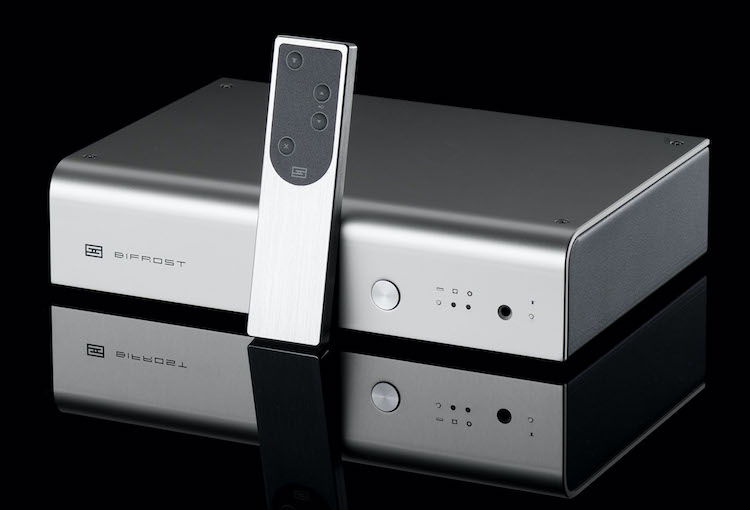
Schiit Audio sold the original Bifrost for around eight years, which is a fairly respectable lifespan for a DAC. The original Bifrost had upgradeable hardware, but you could not upgrade its firmware.
Secrets Sponsor
The new Bifrost 2 is a thorough redesign of the original Bifrost, and it’s now a nearly future-proof DAC. The Bifrost 2 features complete hardware and firmware upgradability, and you can do it yourself without having to send the unit in for service. First, you can upgrade its operating system by yourself, by putting a MicroSD card in the back of the unit. And its chassis is modular, which means when Schiit offers new versions of its modules, you remove a few screws, slide the old module out, slide the new one in, and then put the screws back in.
Oh, and the Bifrost 2 also features both balanced and single-ended outputs, inputs for digital coaxial, optical Toslink, and USB, and a remote control. Those all feed signal to custom digital-to-analog converters designed by Schiit Audio. Two AD5781 converters do the digital conversion and Analog Devices SHARC DSP processors handle the digital filtering. And the USB input utilizes a PIC32 microprocessor using precision local clocks with complete electromagnetic and electrostatic isolation. You can buy one in black or silver. And it’s all designed, built, and supported in California, USA.
That’s a lot of innovation and upgradability in a single component, yet it sells for only $699. But how does it sound? Does a Bifrost 2 DAC even have a sound? How will it improve the sound of the digital audio players I already have? And how can it improve your digital playback?
CONVERSION TYPE:
Schiit True Multibit™
D/A CONVERSION IC:
Two Analog Devices AD5781ARUZ
DIGITAL FILTER:
Proprietary Schiit time- and frequency-domain optimized digital filter implemented on Analog Devices SHARC DSP processor, running 8X oversampling
ANALOG STAGE:
Differential, based on LME49724 for both balanced and single-ended output, direct-coupled throughout
FREQUENCY RESPONSE:
20Hz-20KHz, +/-0.1dB, 2Hz-100KHz, -1dB
MAXIMUM OUTPUT:
2.0V RMS single-ended and 4.0V RMS balanced
TOTAL HARMONIC DISTORTION:
<0.003%, 20Hz-20KHz, at max output
IMD:
<0.004%, CCIR
SIGNAL-TO-NOISE RATIO:
>114dB, referenced to 2V RMS
INPUTS:
Coaxial SPDIF, optical SPDIF, USB
INPUT CAPABILITY:
Up to 24/192 for all inputs
INPUT RECEIVER, SPDIF:
AK4113, USB: Schiit Unison™ USB, based on Microchip PIC32 microprocessor
OUTPUTS:
RCA (single-ended) and XLR (balanced)
OUTPUT IMPEDANCE:
75 ohms for both outputs
POWER SUPPLY:
24VA transformer, 8 stages of regulation, including separate supplies for critical digital and analog sections
UPGRADABILITY:
Autonomy™ architecture with externally replaceable DAC/Analog Card and USB Input Card, plus MicroSD card slot for firmware updates
REMOTE CONTROL:
Included; controls source selection, phase invert, and mute
POWER CONSUMPTION:
12W
DIMENSIONS:
9” long x 6.75” wide x 2” tall
WEIGHT:
5 pounds
FRONT PANEL:
White LED light when the DAC is powered on
REAR PANEL:
IEC power cord socket
AC power switch
One XLR and one RCA output
Coaxial SPDIF, optical SPDIF, USB inputs
MSRP:
$699
Website:
Company Directory:
SECRETS Tags:
schiit audio, bifrost, dac, digital, audio, converter, preamplifier, remote control, reviews 2021, price, value, design, review
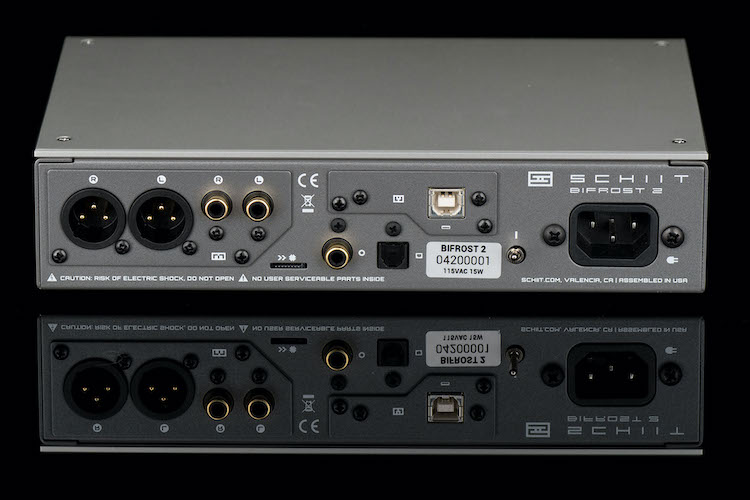
OK, let’s get the history lesson out of the way. “Bifröst” is the rainbow bridge that connects Midgard (Earth) and Asgard (the realm of the gods) in Norse mythology. It’s pronounced “be’vrost.” And it’s a clever name because a DAC is a bridge that connects a digital source to an amplifier. OK, now we can get to the technical stuff.
Now, let’s pay attention to that “2” at the end of the name of the Bifrost. That means this is the second version of the original Bifrost DAC, which was in production for an impressive eight years. And the original Bifrost’s hardware can still be upgraded and it’s still supported. Gotta love that. If that doesn’t say enough about how Schiit Audio is dedicated to its customers, I don’t know what does.
On the inside, the Bifrost 2 is completely different from its predecessor. It’s essentially a ground-up redesign of the original DAC, and everything that could be improved upon or made upgradable was made that way. To begin with, there’s a new improved power supply which utilizes a bigger transformer and has more stages of local regulation. This greatly improves the low-noise performance of the unit. And to make the Bifrost 2 compatible with more components, it now has balanced XLR and single-ended RCA outputs, where the original Bifrost only had single-ended RCA outputs.
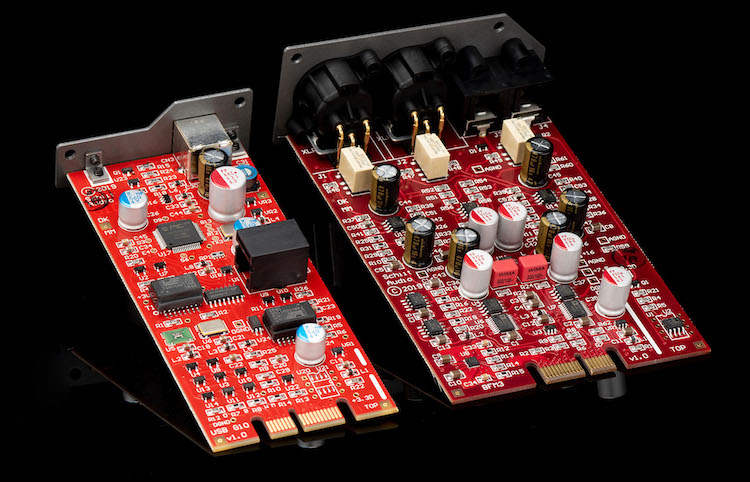
The power supply and outputs of the DAC are essentially its heart, muscles, and skeleton. But it’s with the improvements to the Bifrost’s brain that things get really interesting. The Bifrost 2 uses Schiit Audio’s new Unison USB, which is a unique and proprietary USB input designed by Schiit Audio with no off-the-shelf USB components. And that’s a pretty big deal because that means you can use the Bifrost 2 in a computer-based system. You can connect a computer or a streamer to the Bifrost 2 with a USB 2.0-rated cable that’s no longer than two meters. And that’s all it takes; you don’t need any software drivers for your computer to recognize the Bifrost 2.
And, as if to put a cherry on top of the cake, they now sell the Bifrost 2 with a compact aluminum remote control. It enables you to select inputs, mute the output, and invert the phase. That last feature is a real bonus because a surprising percentage of recordings are out of phase. With a simple click of a button, you may be surprised that the music sounds more focused, or more correct, with its phase reversed.
The Bifrost 2, like all Schiit Audio DACs, is designed to play only a Pulse Code Modulation (PCM) signal up to 24-bit 192kHz, and each of its inputs will accept that bitrate.
The Bifrost 2 is a bit smaller than the average component. At 6.75” wide, 9” long, and 2” high it doesn’t consume a lot of room on your rack, but you’ll want to make sure you have room for all connected cables.
After removing it from the sturdy box Schiit Audio used to ship it, I put it in my cabinet and attached it to my Oppo UDP-205 with a Zu Audio digital cable. I attached its output to a Krell S-550i integrated amplifier with Zu Audio Mission XLR cables. Then I used the included IEC power cable to plug it into a P.I. audio UberBUSS power conditioner. The Krell is powering a pair of Spatial Audio M4 Triode Master speakers.
To turn it on, you flick the power switch up in the back of the unit. The four white LEDs will blink in succession left to right, as the unit powers and does what I assume is a power-on self-test, much like the POST that most home computers do. It’s neat to watch and reminded me of the big UFO from “Close Encounters of the Third Kind.”
I’ve long thought that the digital output of my Oppo BDP-105 and UDP-205 were quite good. Neither player has had any after-market modification, and other than using more upscale power cords with them they’re what I’ve used to listen to digital audio in my main system forever, basically. And I had two or three Oppos before the BDP-105 and UDP-205 but I can’t remember the model numbers. So, I’ve used the Oppos to listen to digital files from a network or USB hard drive, and all types of silver discs. I even run my AppleTV 4K through my Oppo’s DAC via HDMI.
So, I never really seen the need to take the output from an Oppo and run it through an external DAC. The Oppo UDP-205, with its two ESS Technology ES9038PRO DACs, 140dB of dynamic range in a 32-bit, 8-channel DAC, is nothing to sneeze at. I have found the sound quality of the Oppo’s digital output to be satisfactory. This player gives me admirable spatial detail and timbre accuracy and is very easy to listen to. Its sound is very non-fatiguing, and there are times I’ll listen to sound played through the UDP-205 for eight hours straight.

I knew I could improve the digital output of the UDP-205, but I also believed it would cost me more than I am comfortable spending. It seemed to me that the entry-level price for a quality DAC is $2000US, and a lot of those DACs are being manufactured in China. That’s more than I want to spend, and while I have no problem with hardware manufactured in China, I will not spend that kind of money on a component unless I know I can get someone on the phone who will answer questions or tell me where to ship it if it breaks.
But I was in no way prepared for the improvement that the Bifrost 2 brought to my system. I simply did not imagine it was possible. It was the single most bewildering and shocking improvement in the sound quality of my system that I have ever heard, and I’ve been building this system for twenty years.
I did not do anything to break the Bifrost 2 in before I listened to it. I went in free of expectations, as I had never used a DAC in my system before. For my first listening session, I chose the 2007 remastered CD of “Songs of Leonard Cohen.” I’ve listened deeply to this album for over thirty years on vinyl and CD and I thought I was familiar with its every detail. So I chose this album as a challenge, to see if the Bifrost 2 could really show me something new.
So I put in the CD, pressed Play, and my jaw hit the floor. I immediately heard an expansive new aspect of the Cohen album I’d never heard. I have been struggling to find the words to explain the impact it had on me, but here goes. It was as though I had been listening to music that was playing in an aquarium, and suddenly those glass walls were gone. Or, it was like I had been listening to Roy Orbison sing, but someone had completely covered him with cling-film, and suddenly that cling-film was gone and I could hear the full force and nuance of Orbison’s voice. Or, imagine if you were walking down a city street, and passed an auditorium, and you could hear an orchestra playing through the doors. The Bifrost 2 took me off that street and put me in front of that orchestra, and I could now feel the force of the sound on my body, and hear the reverberation in the auditorium, and see each and every instrument. It really was that profound for me.
I believe it took me all of thirty seconds to realize I simply would not remove the Bifrost 2 from my system. I have never made a decision about an audio component that quickly before.
Another surprise was that the Bifrost 2 made Red Book CDs sound the way I thought SACDs were supposed to sound. I’ve tried all of the high-resolution disc formats over the years: Blu-Ray, DVD-A, SACD, and so on, trying to get as much resolution as I can out of a recording. But those formats never seemed to convey as much of the warmth and humanity of a recording that I thought they should. But I get so much more detail out of a CD now thanks to the Bifrost 2 that I am re-discovering my CD library with a lot of excitement. The Bifrost 2 made me think I have been hearing only a quarter of the musical information that’s on my CDs.
I don’t bother with DSD music files, and Schiit Audio doesn’t bother with DSD playback. (In fact, if you find the link to the DSD setup page at the Schiit Audio website, it loads an empty page. I tend to believe that is intentional.) You can play DSD files through a Bifrost 2, provided they’re converted to PCM by something before being sent to the Bifrost 2, but that’s just not something that interests me. The Bifrost 2 can handle up to 24/192 through all three of its inputs, and I listened to a wide variety of high-resolution music files in the AIFF, FLAC, and WAV formats and the Bifrost 2 handled them perfectly well.
Secrets Sponsor
The Krell S-550i integrated amplifier enabled me to easily do A-B testing between the RCA output of the Oppo UDP-205 and the XLR output of the Bifrost 2. I spent a fair amount of time listening to a single source of music and switching between the Oppo and the Bifrost 2, and the differences were far from subtle. The output of the Bifrost 2 beat the RCA output of the Oppo UDP-205 in every conceivable way.
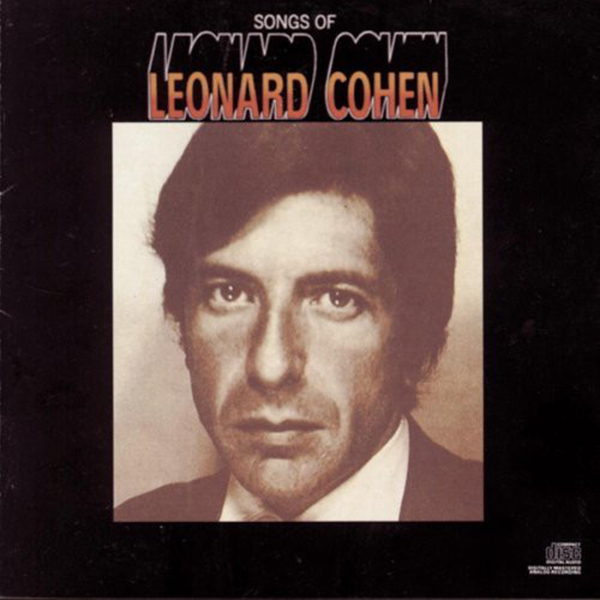
Leonard Cohen, “Songs of Leonard Cohen” (Columbia Legacy CD 88697 04742 2)
As much as I have adored this album for the past thirty years, I have always thought of it as a rather dry and boxed-in recording. The production sounded amateurish, and it sounded like a very poor microphone was used to record Cohen’s voice. Pretty much what you’d expect from a newcomer’s first album.
But the Bifrost 2 showed me just how wrong I was. For the first time, I could hear air around Cohen’s guitar and voice, and the music was no longer boxed in but came out to breathe naturally. For the first time, I could distinguish the instruments being played by the odd marching band that sweeps across the soundstage in the background of “Sisters of Mercy.” I could even hear the clicking of the accordion keys. Timbre improvement was so good that I realized that there’s an oud accompanying Cohen in “So Long, Marianne.” I had always thought it was another guitar. And I had never heard the kick drum or noticed that the drums are stage-right at the beginning of the song and stage-left at the end. So, so many new details of the recording just exploded out of my system with the Bifrost 2. Being able to learn so much new about something I had enjoyed for a very long time felt like a gift.
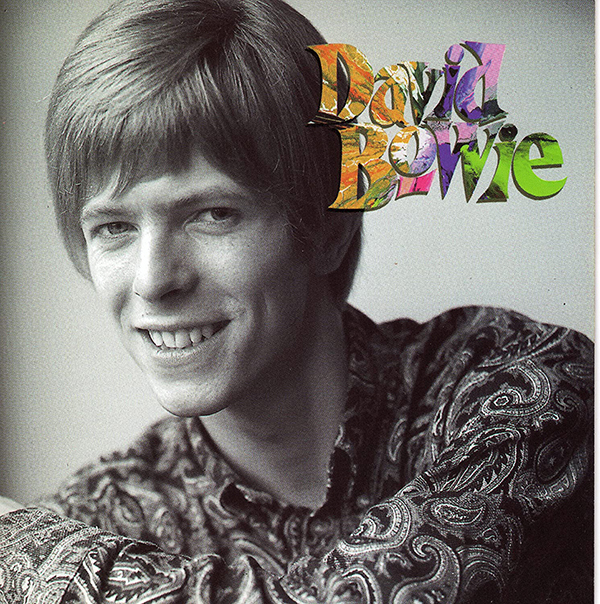
David Bowie, “The Deram Anthology 1966-1968” (Deram CD D121227)
I believe that a lot of Bowie’s greatest work happened in the early part of his career, and you can hear most of it in both mono and stereo on this compilation CD. But the standout track for me is “Please Mr. Gravedigger,” which is a macabre tale of a gravedigging murderer that happens during a thunderstorm. It’s not a song so much as a sound play and would fit right in on a radio show.
It features a clever sound design; the sound of thunder sounds like someone shaking a large sheet of metal, and the sound of boots trudging through the mud is fully convincing. But with the Bifrost 2, the sound completely encompassed my listening room. The stereo system completely disappeared, and I was surrounded by the peal of church bells, the chirps of birds, and the thunder. I felt fully engulfed, as though I was living within the song as though it were a movie. I had never had this quality of playback in my system; it was so good it was hard to believe the recording is over fifty years old and I was listening to a Red Book CD.

Sarah Jarosz, “World On The Ground” (Qobuz 24-bit/44.1kHz streaming)
My Oppo UDP-205 is Roon-ready, and that enabled me to stream Qobuz through the Bifrost 2. Not once did the Bifrost 2 have any trouble with any of the music I streamed, regardless of bitrate. The woody timbres of the guitars and the depth of the vocals of this album were well portrayed by the Bifrost 2. I could find no reason to think that the Bifrost 2 was not improving the sound quality of the music I streamed through Qobuz.
After a few weeks, I couldn’t resist the urge to see if a different power cable would make a difference. So I plugged in a Zu Audio Mission power cable that I’d cooked for two weeks, and the improvement was immediately apparent. The soundstage expanded, mostly from front-to-back but also side-to-side, and separation of individual instruments became more precise. I honestly did not expect that much improvement, but there’s no way I’m going back to the stock cable. Your mileage may vary, of course.
$699 is not a small amount of money, but within the price range of similar DACs, the Schiit Audio Bifrost 2 is an absolute bargain. For that price, you get an upgradable, virtually future-proof DAC that takes input from both stereo components and computers. You’d have to pay many times its asking price to get the sound improvements in other DACs. And you get it from a company with a strong social media presence and proven dedication to customer support.
- Very manageable size.
- Wide variety of inputs.
- Peace of mind knowing it’s upgradeable and I won’t want to replace it anytime soon.
- Provides sound quality improvement beyond what I expected for its price.
- Accepts input from audio streamers, computers, and stereo components.
- Nothing
The Schiit Audio Bifrost 2 DAC exceeded expectations I did not know I had. It added details and a sense of realness to music that I did not know my system was capable of reproducing. After my review of the Schiit Audio Freya+ preamplifier and Vidar amplifier, the sheer bang-for-the-buck quality of the Bifrost 2 comes as no surprise. Schiit Audio really is making it easier, and much less expensive, for people to build very good sound systems. And, considering the Bifrost 2 is squarely in the middle of the range of Schiit Audio’s DACs, I find it hard to imagine how much better the Gungnir ($899) or Yggdrasil ($2499) DACs could be, but I have no doubt they would be purchases I would not regret. I recommend the Schiit Audio Bifrost 2 DAC without reservation. (And if it doesn’t work for you, Schiit Audio has a money-back guarantee.)



